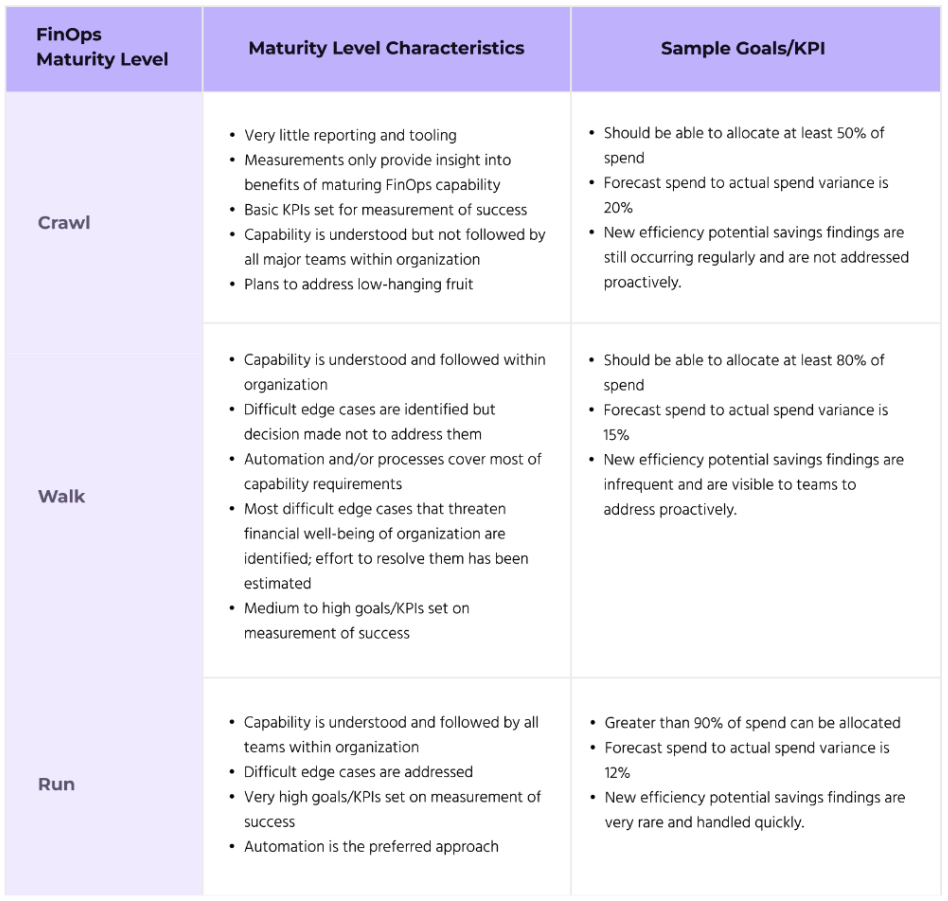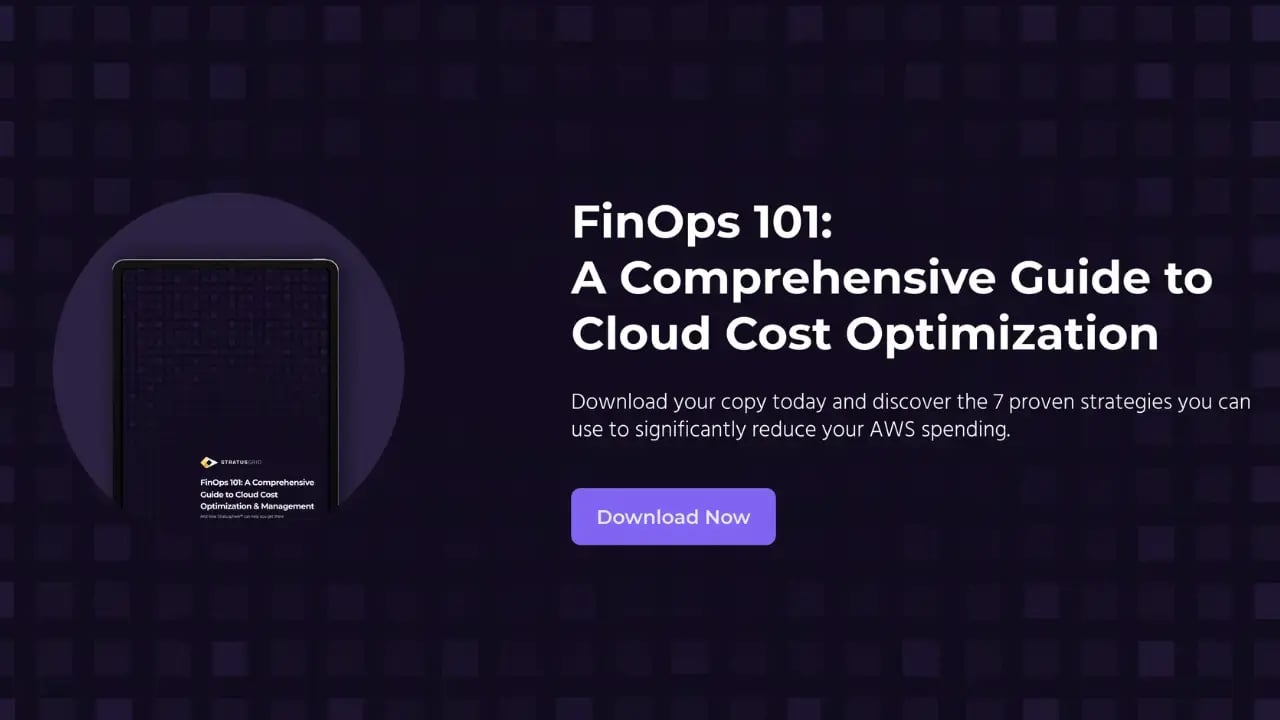What is The FinOps Maturity Model?
The FinOps Maturity Model is a guide that helps you understand how well you are managing your cloud costs. It takes you from learning the basics of cloud cost management to mastering complex cost-saving strategies.
This model also helps you figure out where you are now and what steps you can take to get better at controlling your cloud spending and getting the most value from your investment. It allows you to start small and mature as your business scales in complexity.
There is no “one-size-fits-all” way to implement a successful FinOps practice, but excellence is achieved by taking incremental steps.
The FinOps Foundation proposes three phases of FinOps maturity: Crawl, Walk, and Run. Each stage shows how advanced your management practices are. Understanding your organization's current stage helps you set realistic, smart goals for finOps maturity.
FinOps Maturity Model Guidelines

Do I have to ‘run’ to achieve FinOps excellence?
No, you don't need to make every aspect of FinOps perfect. Your goal should be to improve the FinOps capabilities that bring the most benefit to your company. For instance, if making a competency better from a basic to an advanced level doesn't add extra value, then there's no need to push it further. Instead, focus on improving other areas that can bring more benefits when enhanced.
Let us help you break down each stage and give you actionable tips that may help you move from one stage to the next. We will also introduce you to StratusGrid’s cloud cost optimization tool: Stratusphere™ FinOps, a custom-built software for large enterprises and private equity firms to take control of their cloud spending.
With Stratusphere™ FinOps, you can rapidly gain insights into your AWS environments and inform optimal focuses for value creation. This is done with prebuilt dashboards to drive your management framework and unique features to help bridge the gap between technology and finance, like actionable insights ranked by level of effort. You can start a free trial and try Stratusphere™ FinOps yourself here.
.webp?width=3632&height=1880&name=StratusGrid-Cloud-Maturity-Assessment%20(1).webp)
1. The 'Crawl' Stage [ You’re Just Starting Out]
The "Crawl" phase is the first step in aligning your company's cloud usage with its financial goals. You're just beginning to understand your cloud costs. At this stage, actions are usually taken after noticing the cloud spend is higher than expected rather than planning in advance to avoid overuse.
How to know if you're in this stage:
- You're just starting to look at cloud costs.
- There's no clear process or policy for managing cloud expenses.
- Cloud spending is monitored manually or not consistently.
In this stage, your main task is to find out where you're spending money and try to cut unnecessary costs by:
- Understanding costs: Figuring out what you're currently spending on cloud services and why.
- Allocating spend: Assigning cloud costs to different parts of the business to see who's using what.
- Tracking spending: Keeping an eye on how much is being spent on cloud services.
- Setting up basic reporting: Starting to make simple reports to see spending patterns.
- Setting up budgets: Creating budgets to control costs and avoid surprises.
Common challenges companies face in their crawl stage:
- Lack of visibility: Not knowing where all the money is going in the cloud.
- No clear policies: Not having rules on how to use cloud resources efficiently.
- Unexpected costs: Getting surprised by high bills due to unmonitored usage.
Stratusphere™ FinOps can assist companies in the "Crawl" stage of the FinOps maturity model to advance their cloud cost management practices. Here's how:
- Actionable insights for AWS cost optimization: Stratusphere™ FinOps provides clear, actionable insights to optimize AWS costs ranked by level of effort (LoE), crucial to managing cloud expenses.
- Smart contextual guidance: The platform offers pre-built insights, which eliminates the need for custom dashboards or complex data projects. This guidance helps you focus on essential areas, ideal for those in the early stages of cloud cost management.
- Visibility and savings tracking: You can set benchmark targets and gain insights into AWS usage and potential savings. This level of detail and visibility is crucial for you to understand your spending patterns and identify optimization opportunities.
- Data sharing and ownership: Stratusphere™ FinOps allows for easy data sharing across organizations while maintaining data ownership. This feature supports collaboration and insight sharing without complex legal processes. Learn from the best-performing accounts to standardize practices across complex cloud environments.
- Comprehensive visibility into AWS environments: The platform provides a detailed view of AWS cloud costs, breaking it down per accounts and services. This visibility helps in identifying cost-saving opportunities and understanding spending trends.
- Tailored financial analysis: Stratusphere™ FinOps's dashboard is designed to mirror a P&L report, which makes it user-friendly for finance professionals. This feature allows you to align cloud usage costs with financial projections, and to enhance your financial modeling and decision-making without time-consuming data projects.
2. The 'Walk' Stage [You’re Getting Better]
In the "Walk" phase, your company is making progress in aligning cloud usage with financial goals for better efficiency and savings. You've moved beyond just understanding cloud costs; now you're proactively implementing processes and policies to manage and optimize those costs.
How to know if you're in this stage:
- Your organization employs more detailed mapping of cloud resources to business needs.
- You have basic processes and policies for cloud cost management in place.
- You have established reporting and forecasting practices for cloud spending.
- There's a conscious effort to align cloud usage with budget and cost considerations.
- Cloud spending is monitored regularly, and there's a proactive approach to managing costs.
- You're starting to use tools or platforms to help with cloud cost management.
Your main tasks are to refine your cost management by:
- Enhancing visibility: Developing more detailed tracking and reporting to understand cloud costs better.
- Improving allocation: Fine-tuning how you assign cloud costs to ensure accuracy and accountability.
- Rightsizing: Adjusting cloud resources to match the actual needs, avoiding over-provisioning.
- Optimizing costs: Identifying and shutting down unused or underutilized resources. You should be moving beyond basic cost-saving measures to more strategic cost optimization.
- Implementing policies: Develop policies and architecture to anticipate and control cloud spend. You must establish clear guidelines for cloud usage to prevent wasteful spending.
- Forecasting and planning: Beginning to predict future cloud spending based on historical data and trends.
- Stakeholder involvement: Engaging more stakeholders in the decision-making process to balance various interests.
Common challenges companies face in their walk stage:
- Maturing processes: Evolving initial processes and policies to be more effective and comprehensive.
- Cost optimization: Finding more sophisticated ways to reduce costs without impacting performance.
- Stakeholder engagement: Ensuring all parts of the business understand and adhere to cloud cost management policies.
- Cultural shifts: Encouraging a company-wide mindset change to prioritize cloud cost efficiency.
- Balancing interests: Making decisions that align with both technical needs and budgetary constraints.
- Advanced forecasting: Developing accurate forecasting models to predict future cloud spending.
Stratusphere™ FinOps can be a valuable partner for companies in the "Walk" stage of the FinOps maturity model, helping to further refine and optimize cloud cost management practices. Here's how:
- Advanced mapping and reporting: Stratusphere™ FinOps provides sophisticated tools for mapping cloud usage and generating detailed reports, helping you understand your cloud spend in the context of your business needs.
- Enhanced prioritization: The platform helps you identify and prioritize more advanced cost-saving opportunities, with a clear understanding of the level of effort associated with each finding allowing you to focus on low-effort high-impact work.
- Monitor commitment-based savings: With Stratusphere™ FinOps you can monitor and adjust your commitment-based savings plan.
- Improved visibility and control: Improve your organization’s visibility into a complex environment with advanced filtering capabilities that allow you to focus on cost optimization opportunities company by company and account by account.
- Empowering finance teams: Provide your finance team with comprehensive analyses to understand trends easily. Our tabular presentation links usage costs to your financial projections, aiding in correlating data such as monthly active users or content viewing time. Plus, the profit and loss (P&L) reports are readily exportable, helping your team refine their financial models and enhance forecasting accuracy.
- Collaboration and communication: Facilitate better collaboration and communication across teams with shared insights and reports, ensuring everyone is aligned on cost management goals.
- Predictive analytics: Utilize Stratusphere™ FinOps's capabilities to forecast future spending and plan accordingly, helping to avoid unexpected costs and optimize budgeting.
See Stratusphere™ FinOps in Action Here:
3. The 'Run' Stage [Advanced Management]
In the "Run" phase, your company has reached an advanced level of cloud cost management, where FinOps processes are largely automated, and FinOps practices are deeply integrated into the organization's fabric. This stage is about fine-tuning and optimizing these processes for efficiency and effectiveness.
How to know if you're in this stage:
- Your organization has automated key FinOps processes like tagging, reporting, and optimization.
- FinOps is a core part of your business strategy, fully integrated into daily operations.
- You focus on setting realistic goals and refining processes over time for continuous improvement.
In this stage, your main tasks are to excel in cloud cost management by:
- Advanced automation: Implementing sophisticated automation for cloud cost management tasks to ensure efficiency and accuracy.
- Continuous optimization: Regularly refining and optimizing cloud resources and costs based on real-time data and insights.
- Strategic tagging and allocation: Employing advanced tagging strategies for precise cost allocation and insightful reporting.
- Goal setting and refinement: Establishing realistic, achievable goals for cloud cost management and continuously refining strategies to meet these goals.
Common challenges companies face in their run stage:
- Avoiding over-complexity: Balancing the desire for detailed optimization with the need to maintain manageable and understandable processes.
- Continuous improvement: Keeping up with the latest FinOps practices and cloud cost management technologies to stay at the forefront of efficiency.
- Maintaining automation: Ensuring that automated processes remain effective and adapt to changes in cloud usage or business needs.
The State of FinOps 2024 report highlights a significant shift towards prioritizing automation, which reflects a growing desire among organizations to mature their FinOps practices and an inclination towards integrating more automation, streamlining their operations, and enhancing efficiency as they aim to progress to more advanced stages of FinOps maturity.
Stratusphere™ FinOps is particularly beneficial for companies in the "Run" stage because it offers solutions that enhance and support advanced FinOps practices:
- Real-time optimization insights: The platform delivers real-time data and insights, which enables continuous optimization of cloud resources and costs.
- Goal-driven analytics: The platform can help you set and refine your FinOps goals, providing you with analytics and insights to track your progress and inform decision-making.
- Continuous learning and improvement: By offering insights into the latest trends and best practices in FinOps, Stratusphere™ FinOps helps companies stay ahead in their cloud cost management journey. Additionally, the team behind Stratusphere™ FinOps, StratusGrid, a certified AWS partner, cab provide invaluable support. We can assist with best practices, offer tips, help interpret data, and even implement recommendations to achieve cost savings, ensuring you maintain your competitive edge.
How Do I Assess My FinOps Maturity Level?
Now that you have familiarized yourself with the key stages of FinOps maturity, it’s time to find out which stage you're at to set goals and decide what to focus on to level up. Here’s a quick guide on how to do this:
- Review your tools and processes: Analyze the tools and processes you currently use for cloud cost management. Advanced tools and automated processes indicate a higher maturity level.
- Check stakeholder engagement: Evaluate how well different stakeholders (like IT, finance, and business units) are involved in FinOps processes. Higher engagement and collaboration suggest a more mature FinOps practice.
- Assess your optimization practices: Look at how your organization approaches cost optimization. Are you just identifying quick wins, or are you also engaging in strategic optimization based on detailed analysis?
- Consider your reporting and forecasting capabilities: Mature FinOps practices involve detailed reporting and accurate forecasting. Assess the sophistication of your reporting and whether you use predictive analytics for forecasting.
- Seek external input: Sometimes, it's beneficial to get an external perspective. Consider engaging with a FinOps consultant or using cost assessment tools provided like Stratusphere™ FinOps to get an unbiased view of your maturity level.
- Document and plan: Once you've assessed your current stage, document your findings and plan how to address gaps. This plan should outline steps to evolve your FinOps practices to the next maturity level.
How to Progress Through FinOps Maturity Each Stage
Progressing through each stage of FinOps maturity requires you to mature as your business scales in complexity. Here are some tips that may help you progress through each stage:
From Crawl to Walk:
- Establish formal policies: Develop and implement formal policies for cloud usage and cost management. This includes defining roles, responsibilities, and processes for monitoring and optimizing costs.
- Improve visibility and reporting: Enhance your visibility into cloud costs with more detailed tracking and reporting. Use cost management and optimization tools that provide insights into usage patterns, cost trends, and forecasting.
- Engage stakeholders: Increase engagement with stakeholders across different departments. Ensure they understand the importance of FinOps and their role in optimizing cloud costs.
- Introduce proactive optimization: Shift from reactive to proactive optimization. Start identifying and implementing cost-saving measures before costs overrun.
- Invest in training: Educate your team on FinOps principles and best practices. Training can help build a culture that values cost optimization and efficient cloud usage.
- Leverage automation: Begin to automate simple FinOps tasks, such as alerting for budget overruns or automated tagging of resources.
From Walk to Run:
- Advanced automation: Implement advanced automation for more complex FinOps processes, such as automated rightsizing of resources or predictive cost management.
- Integrate FinOps into business processes: Ensure that FinOps practices are fully integrated into all relevant business processes.
- Sophisticated forecasting and budgeting: Develop more sophisticated forecasting models that can predict future cloud spending with high accuracy. Align these forecasts with your budgeting processes.
- Optimize cost allocation: Refine your cost allocation methods to ensure they accurately reflect the usage and help in making informed business decisions.
- Continuous improvement: Establish a continuous improvement process for your FinOps practices. Regularly review your processes, tools, and policies to identify areas for enhancement.
- Strategic business alignment: Ensure that your FinOps strategies align with broader business objectives, facilitating decision-making that supports both cost optimization and business growth.
- Community engagement: Engage with the FinOps community to stay updated on best practices, tools, and strategies. Share your learnings and adopt insights from the community to enhance your FinOps maturity.
Maximize Your AWS Cloud ROI with Stratusphere™ FinOps and StratusGrid
The FinOps maturity model helps you control cloud costs at every stage. No matter your stage, Stratusphere™ FinOps can help you manage and reduce your cloud costs.
Stratusphere™ FinOps from StratusGrid is a custom-built cost optimization dashboard for large enterprises and private equity firms to take control of their cloud spending. With Stratusphere™ FinOps, companies can rapidly gain insights into their AWS environments and inform optimal focuses for value creation. This is done with prebuilt dashboards to drive your management framework and unique features to help bridge the gap between technology and finance like actionable insights ranked by level of effort. Start a free trial now!
StratusGrid can also help pinpoint your current FinOps maturity level and provide strategic recommendations to move you forward. Contact us to see how we can help.
BONUS: Download Your FinOps Guide to Effective Cloud Cost Optimization Here ⤵️


